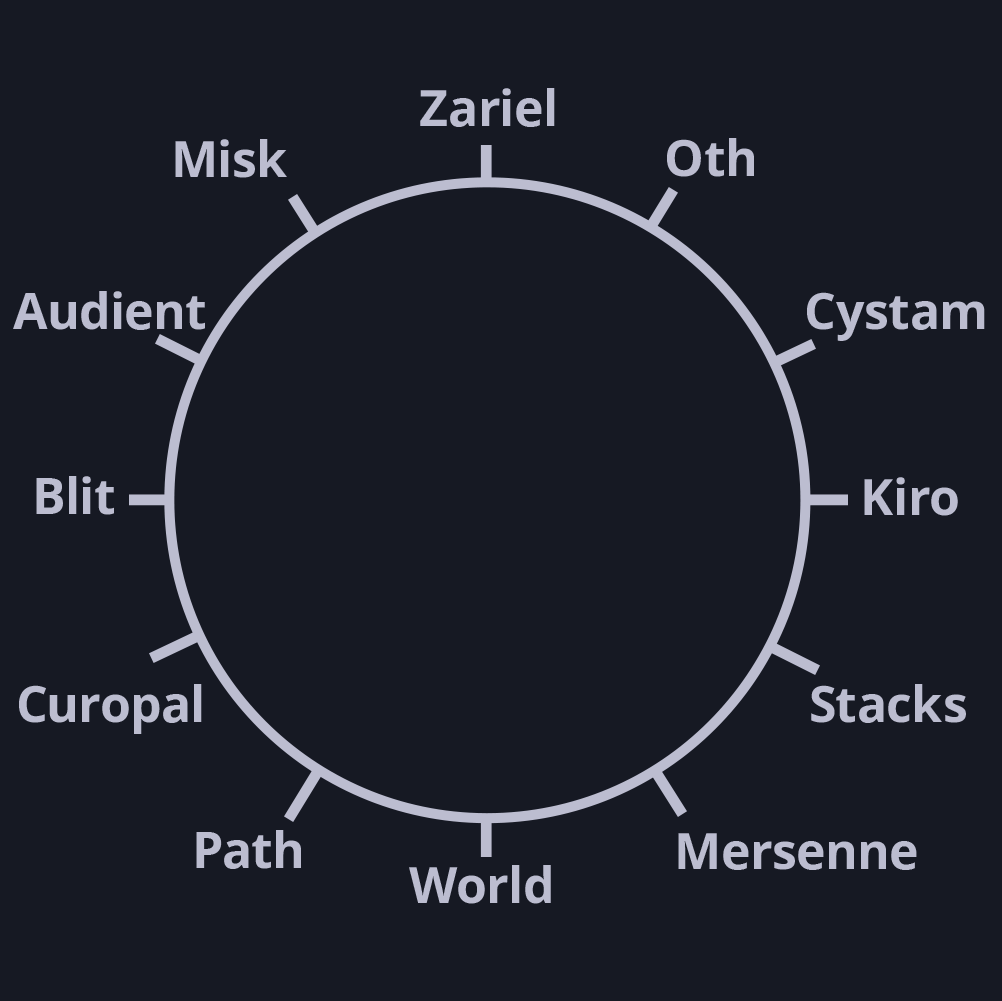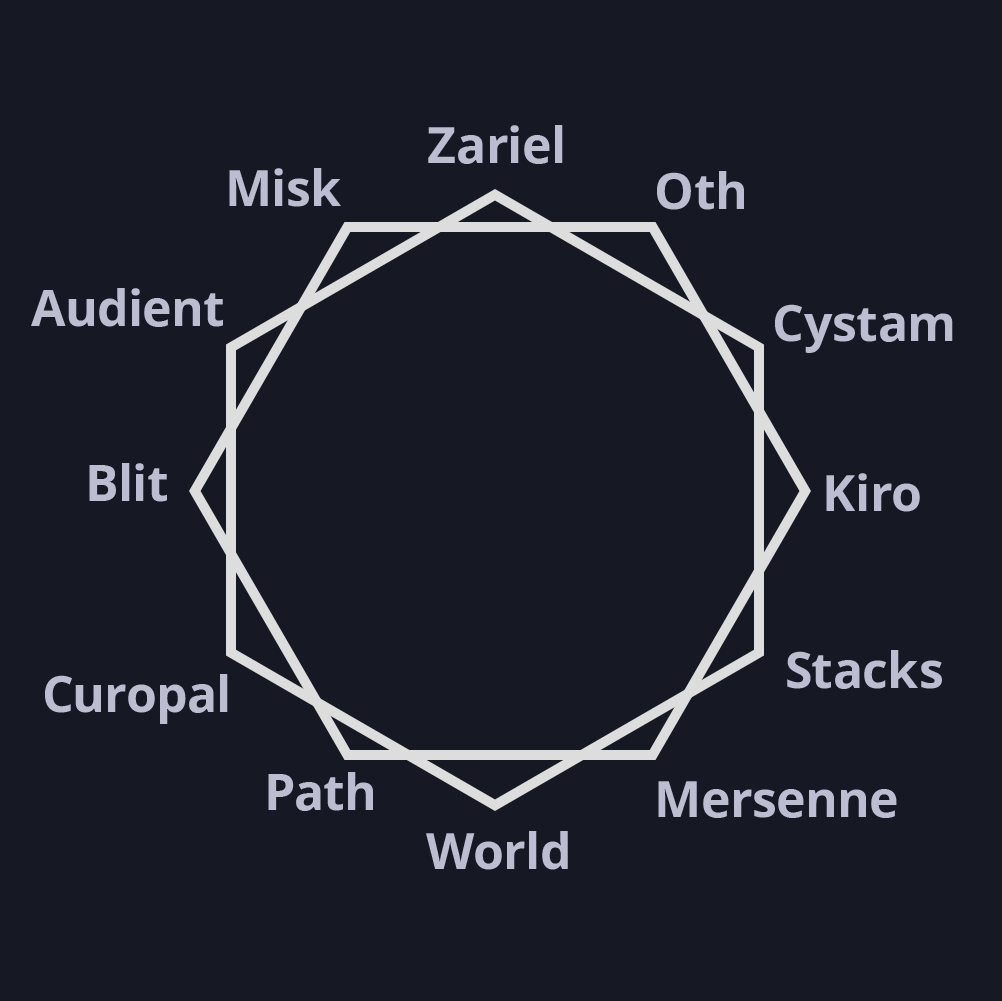The Twelve and the Wheel
How do we organize all of the concepts in our set of lenses? There are so many!
We're going to start with twelve points, on a wheel, organized like the times on a clock.
This is wholly artificial organization! But it's convenient and evocative.
Why 12?
12 is a number with many divisors: 12 can be divided easily into 6, 4, 3, and 2.
Numbers with many divisors tend to be practical and pleasant to work with and show up frequently in myth, legend, and engineering: time has 12 hours1 (and 60 minutes, 60 being another number with many divisors), music has 12 notes, the year has 12 months, there are 12 basic hues in the color wheel, it's a number that feels complete.
and 60 minutes. 60 is another number with many divisors: numbers in this set,
2, 6, 12, 60, 120, 360, pop up often.
Why a Wheel?
The obvious symbolic connection with clocks, the circle of fifths and the color wheel help.
It also creates a few useful outcomes:
- Elements in the wheel are naturally opposed to elements on the opposite side of the wheel.
- Those "naturally opposed" elements are positions where we can create conflict, and conflict is good.
- The beginning of the wheel is linked to the end of the wheel.
- A wheel is a visually pleasing arrangement.
Each Spoke is an Archetype
At each of the twelve positions on the wheel we are going to put a thing.
That thing? One of our 12 archetypes.
Let's Name Every Archetype

"What, it's just a bunch of weird names? I can come up with my own weird names."
Okay, yes - you can, and should. These are placeholder names: I need a name for each spoke, so that I can track all of these mixed metaphors across each of their different invocations.
As we explore the various lenses in which the archetypes exist, that wheel will start to get very crowded with more information about each spoke.
That's Not A Circle, That's a Dodecagon!
You make a good point, but somehow when I arrange it that it makes me look like a crazy person:

Even I'm just self-aware enough not to try and get folks on board with the mythology dodecagon.
It's a circle. A nice, easy-to-work-with circle. Forget you ever saw a dodecagon.
Natural Conflict Between Archetypes
Broadly, let's get some thematic tension up in this system!
- Oth and Path will represent Order vs. Chaos
- Cystam and Curopal will represent Extroversion vs. Introversion
- Kiro and Blit will represent Optimism vs. Pessimism
- Stacks and Audient will represent Thinking vs. Feeling
- Mersenne and Misk will represent Creativity vs. Practicality
- World and Zariel will represent the Antagonist vs. the Protagonist
These themes will be explored much more thoroughly in the individual lenses.
Archetypes
Now, let's start with a brief overview of each of the archetypes:
1. Oth, The Warden
Oth is the archetype of security, order, and constraints.
2. Cystam, The Broadcaster
Cystam is the archetype of connection, signal, noise, and announcement.
3. Kiro, The Trumpet
Kiro is the archetype of optimism, new beginnings, initiative, and inspiration.
4. Stacks, The Archivist
Stacks is the archetype of knowledge, detail, revelation, and exposition.
5. Mersenne, The Jester
Mersenne is the archetype of chaos, luck, madness, insight, and cleverness.
6. World, The General
World is the archetype of challenge, honor, and antagonism.
7. Path, The Freelancer
Path is the archetype of freedom, anarchy, and rebellion.
8. Curopal, The Servant
Curopal is the archetype of hidden agendas, facades, and betrayal.
9. Blit, The Artist
Blit is the archetype of art, grief, despair, emotion, and expression.
10. Audient, The Seer
Audient is the archetype of faith, hope, apotheosis, transcendance and omniscience.
11. Misk, The Quartermaster
Misk is the archetype of collection, recovery, wrap-up, loose-ends, utility, and adaptation.
0/12. Zariel, The Marionette
Zariel is the archetype of choice, fate, meta-awareness and inevitability.
Okay! Now What?
Our next step is to talk about the various different interpretive lenses we can apply to each of these archetypes!
We're going to start with characterization: who are each of these?